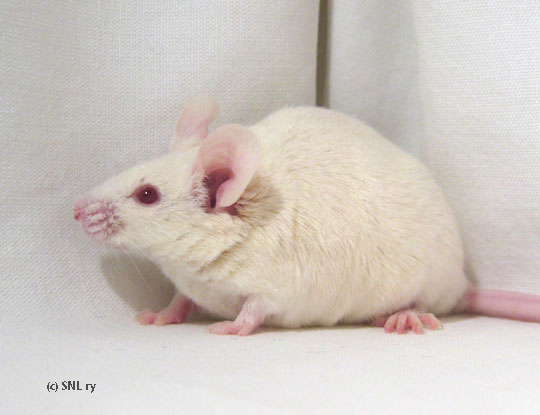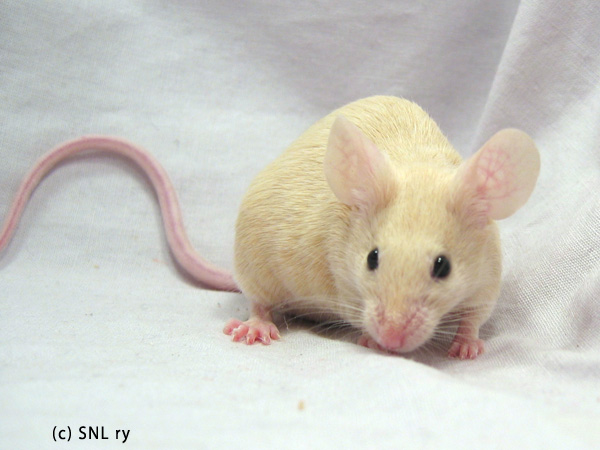Varieties
Undstandardized
Cream (cr)
Ay/* cch/cch D/* P/* (b.e.cream)
Ay/* cch/cch D/* p/p (p.e.cream)
"The colour should be rich cream, like pastel yellow, without grayness or sootiness. Eyes black or pink."
Breeding information below the pictures.
Variety Information
Cream is genetically a red or a fawn with two chinchilla genes, depending on the eye colour. The standard describes a warm and rich shade of cream, that also covers the belly, free from being sooty or mealy. At the moment cream is an unstandardised variety.
Cream is a rare variety, it is especially hard to find in its genetically pure form. The problem is the same as with marten sable: untypical, more or less sooty Ay-based c-recessive mice are plenty, but breeding them to pure cream colour means a lot of work – even more so with cream than with marten sable, as shading is a fault with cream and suitable “correcting” varieties don’t really exist.
If you are starting from scratch, pairing sepia or grey agouti with red or fawn gives you a start. Another possibility is to make use of the untypical “cream” mice available and to try to selectively breed for pure cream colour. Sepia is a useful variety to breed cream with, if there are any available. However, they may sometimes introduce unpleasant surprises, because sepia may carry strong umbrous factors which will result in a shading or sootiness in cream. Using grey agouti helps to avoid the problem with umbrous (umbrous factors would show as concentration of ticking on grey agouti), but they also have the agouti gene which is not the most desired in cream.
The most common fault in black eyed cream is sootiness, meaning a tendency to develop shading on the back. Pink eyed creams do not suffer from this problem as much, because p/p dilutes the sootiness so that it doesn’t really show. Wrong shade is another problem of cream; the shade may be too light, even nearly white, or too dark. Mealy colour or light belly colour are also common faults: the cause for these may be the agouti gene or especially white bellied agouti –gene. The best a-locus genotype for cream is Ay/a.
Unfortunately, there aren’t really any other cch/cch varieties that would be suitable to breed together with cream. Using chinchilla or argente crème introduces the unwanted Aw gene to cream. Black fox and marten sable would cause shading or sootiness. The least harmful varieties to breed with cream are grey agouti or pale argente. Sepia is a non-standardisable variety that can be bred to cream.
Pink eyed cream is slightly easier to breed than black eyed cream, as its shade is not so easily compromised by umbrous factors. The downside of pink eyed cream are the unwanted mock-pew’s born in cream litters, if the genotype of the parents is Ay/a p/p. These should not be used for breeding anything else but cream.
In addition to wrong c-recessive genes and Aw, other genes to avoid include blue dilution (d/d). Blue dilution makes the cream shade cold and pale. Chocolate genes (b/b) are not necessarily bad, but they may make the cream colour too dark.
Outside Finland it should be noted that the names for different colour varieties may vary. The variety most commonly referred to as “cream” abroad is a/a ce/c, that is black eyed bone in Finland. Beige may also be referred to as “cream”. The cream of our standard is virtually non-existent in the fancy outside Finland.


